Bow and arrow
The bow and arrow is a ranged weapon system consisting of an elastic launching device (bow) and long-shafted projectiles (arrows).
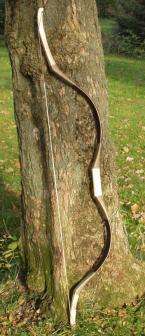
Archery is the art, practice, or skill of using bows to shoot arrows.[1] A person who shoots arrows with a bow is called a bowman or an archer. Someone who makes bows is known as a bowyer,[2] one who makes arrows is a fletcher,[3] and one who manufactures metal arrowheads is an arrowsmith.[4]
Humans used bows and arrows for hunting and violence long before recorded history, and the practice was common to many prehistoric cultures. They were important weapons of war from ancient history until the early modern period, where they were rendered increasingly obsolete by the development of the more powerful and accurate firearms, and were eventually dropped from warfare. Today, bows and arrows are mostly used for hunting and sports.
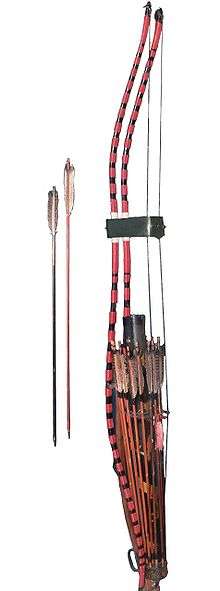
Basic design and use
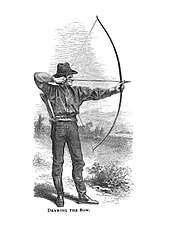
A bow consists of a semi-rigid but elastic arc with a high-tensile bowstring joining the ends of the two limbs of the bow. An arrow is a projectile with a pointed tip and a long shaft with stabilizer fins (fletching) towards the back, with a narrow notch (nock) at the very end to contact the bowstring.
To load an arrow for shooting (nocking an arrow), the archer places an arrow across the middle of the bow with the bowstring in the arrow's nock. To shoot, the archer pulls back (draws) the arrow and the bowstring, which in turn flexes the bow limbs, storing elastic energy. Typically while maintaining the draw, the archer sights along the arrow to aim it. Finally the archer releases (looses) the arrow, allowing the limbs' stored potential energy to convert into kinetic energy, which is transmitted via the bowstring to the arrow, propelling it to fly forward with high velocity.[5]
A container or bag for additional arrows for quick reloading is called a quiver.
When not in use, bows are generally kept unstrung, meaning one or both ends of the bowstring are detached from the bow. This removes all residual tension on the bow, and can help prevent it from losing strength or elasticity over time. For many bow designs, this also lets it straighten out more completely, reducing the space needed to store the bow. Returning the bowstring to its ready-to-use position is called stringing the bow.
History
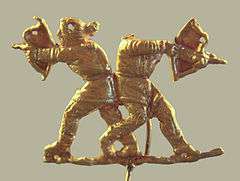
The oldest known evidence of arrows comes from the South African site of Sibudu Cave, where the remains of bone and stone arrowheads have been found dating to approximately 70,000–60,000 years ago.[6][7][8][9][10]
In Eurasia, the bow and arrow appears (or reappears) around the transition from the Upper Paleolithic to the Mesolithic. After the end of the last glacial period, use of the bow seems to have spread to every inhabited region, except for Australasia and most of Oceania.[11]
The earliest arrow found outside of Africa has been discovered in 2020 in Fa Hien Cave, Sri Lanka. It has been dated to 48,000 years ago. "Bow-and-arrow hunting at the Sri Lankan site likely focused on monkeys and smaller animals, such as squirrels, Langley says. Remains of these creatures were found in the same sediment as the bone points."[12][13]
The earliest definite remains of bow and arrow from Europe are possible fragments from Germany found at Mannheim-Vogelstang dated 17,500–18,000 years ago, and at Stellmoor dated 11,000 years ago. Azilian points found in Grotte du Bichon, Switzerland, alongside the remains of both a bear and a hunter, with flint fragments found in the bear's third vertebra, suggest the use of arrows at 13,500 years ago.[14] At the site of Nataruk in Turkana County, Kenya, obsidian bladelets found embedded in a skull and within the thoracic cavity of another skeleton, suggest the use of stone-tipped arrows as weapons about 10,000 years ago.[15] Microliths discovered on the south coast of Africa suggest that projectile weapons of some sort may be at least 71,000 years old; however, these may have been used to tip atlatl darts, rather than arrowheads.[16]
The oldest extant bows in one piece are the elm Holmegaard bows from Denmark which were dated to 9,000 BCE. Several bows from Holmegaard, Denmark, date 8,000 years ago.[17] High-performance wooden bows are currently made following the Holmegaard design. The Stellmoor bow fragments from northern Germany were dated to about 8,000 BCE, but they were destroyed in Hamburg during the Second World War, before carbon 14 dating was available; their age is attributed by archaeological association.[18]
The bow was an important weapon for both hunting and warfare from prehistoric times until the widespread use of gunpowder in the 16th century. Organised warfare with bows ended in the mid 17th century in Europe, but it persisted into the early 19th century in Eastern cultures and in hunting and tribal warfare in the New World. In the Canadian Arctic bows were made until the end of the 20th century for hunting caribou, for instance at Igloolik.[19] The bow has more recently been used as a weapon of tribal warfare in some parts of Sub-Saharan Africa; an example was documented in 2009 in Kenya when Kisii people and Kalenjin people clashed, resulting in four deaths.[20][21]
The British upper class led a revival of archery as a sport in the late 18th century.[22] Sir Ashton Lever, an antiquarian and collector, formed the Toxophilite Society in London in 1781, under the patronage of George, then Prince of Wales.
Construction
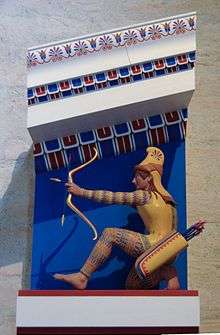
Parts of the bow
The basic elements of a bow are a pair of curved elastic limbs, traditionally made from wood, joined by a riser. Both ends of the limbs are connected by a string known as the bow string.[5] By pulling the string backwards the archer exerts compressive force on the string-facing section, or belly, of the limbs as well as placing the outer section, or back, under tension. While the string is held, this stores the energy later released in putting the arrow to flight. The force required to hold the string stationary at full draw is often used to express the power of a bow, and is known as its draw weight, or weight.[23][24] Other things being equal, a higher draw weight means a more powerful bow, which is able to project heavier arrows at the same velocity or the same arrow at a greater velocity.
The various parts of the bow can be subdivided into further sections. The topmost limb is known as the upper limb, while the bottom limb is the lower limb. At the tip of each limb is a nock, which is used to attach the bowstring to the limbs. The riser is usually divided into the grip, which is held by the archer, as well as the arrow rest and the bow window. The arrow rest is a small ledge or extension above the grip which the arrow rests upon while being aimed. The bow window is that part of the riser above the grip, which contains the arrow rest.[5]
In bows drawn and held by hand, the maximum draw weight is determined by the strength of the archer.[24] The maximum distance the string could be displaced and thus the longest arrow that could be loosed from it, a bow's draw length, is determined by the size of the archer.[25]
A composite bow uses a combination of materials to create the limbs, allowing the use of materials specialized for the different functions of a bow limb. The classic composite bow uses wood for lightness and dimensional stability in the core, horn to store energy in compression, and sinew for its ability to store energy in tension. Such bows, typically Asian, would often use a stiff end on the limb end, having the effect of a recurve.[26] In this type of bow, this is known by the Arabic name 'siyah'.[27]
Modern construction materials for bows include laminated wood, fiberglass, metals,[28] and carbon fiber components.
Arrows
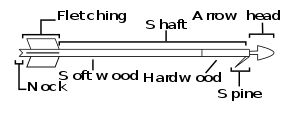
An arrow usually consists of a shaft with an arrowhead attached to the front end, with fletchings and a nock at the other.[29] Modern arrows are usually made from carbon fibre, aluminum, fiberglass, and wood shafts. Carbon shafts have the advantage that they do not bend or warp, but they can often be too light weight to shoot from some bows and are expensive. Aluminum shafts are less expensive than carbon shafts, but they can bend and warp from use. Wood shafts are the least expensive option but often will not be identical in weight and size to each other and break more often than the other types of shafts.[30] Arrow sizes vary greatly across cultures and range from very short ones that require the use of special equipment to be shot to ones in use in the Amazon River jungles that are 2.6 m (8.5 feet) long. Most modern arrows are 55 to 75 cm (22 to 30 inches) in length.[29]
Arrows come in many types, among which are breasted, bob-tailed, barreled, clout, and target.[29] A breasted arrow is thickest at the area right behind the fletchings, and tapers towards the (nock) and head.[31] A bob-tailed arrow is thickest right behind the head, and tapers to the nock.[32] A barrelled arrow is thickest in the centre of the arrow.[33] Target arrows are those arrows used for target shooting rather than warfare or hunting, and usually have simple arrowheads.[34]
For safety reasons, a bow should never be shot without an arrow nocked; without an arrow, the energy that is normally transferred into the projectile is instead directed back into the bow itself, which will cause damage to the bow's limbs.
Arrowheads
The end of the arrow that is designed to hit the target is called the arrowhead. Usually, these are separate items that are attached to the arrow shaft by either tangs or sockets. Materials used in the past for arrowheads include flint, bone, horn, or metal. Most modern arrowheads are made of steel, but wood and other traditional materials are still used occasionally. A number of different types of arrowheads are known, with the most common being bodkins, broadheads, and piles.[35] Bodkin heads are simple spikes made of metal of various shapes, designed to pierce armour.[32] A broadhead arrowhead is usually triangular or leaf-shaped and has a sharpened edge or edges. Broadheads are commonly used for hunting.[36] A pile arrowhead is a simple metal cone, either sharpened to a point or somewhat blunt, that is used mainly for target shooting. A pile head is the same diameter as the arrow shaft and is usually just fitted over the tip of the arrow.[37] Other heads are known, including the blunt head, which is flat at the end and is used for hunting small game or birds, and is designed to not pierce the target nor embed itself in trees or other objects and make recovery difficult.[32] Another type of arrowhead is a barbed head, usually used in warfare or hunting.[29]
Bowstrings
Bowstrings may have a nocking point marked on them, which serves to mark where the arrow is fitted to the bowstring before shooting.[38] The area around the nocking point is usually bound with thread to protect the area around the nocking point from wear by the archer's hands. This section is called the serving.[39] At one end of the bowstring a loop is formed, which is permanent. The other end of the bowstring also has a loop, but this is not permanently formed into the bowstring but is constructed by tying a knot into the string to form a loop. Traditionally this knot is known as the archer's knot, but is a form of the timber hitch. The knot can be adjusted to lengthen or shorten the bowstring. The adjustable loop is known as the "tail".[40] The string is often twisted (this being called the "flemish twist").
Bowstrings have been constructed of many materials throughout history, including fibres such as flax, silk, and hemp.[41] Other materials used were animal guts, animal sinews, and rawhide. Modern fibres such as Dacron or Kevlar are now used in commercial bowstring construction, as well as steel wires in some compound bows.[42] Compound bows have a mechanical system of pulley cams over which the bowstring is wound.[39] Nylon is useful only in emergency situations, as it stretches too much.[43]
Types of bow
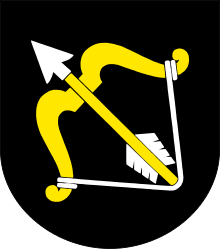
There is no one accepted system of classification of bows.[44] Bows may be described by various characteristics including the materials used, the length of the draw that they permit, the shape of the bow in sideways view, and the shape of the limb in cross-section.[45]
Commonly-used descriptors for bows include:
By side profile
- Recurve bow: a bow with the tips curving away from the archer. The curves straighten out as the bow is drawn and the return of the tip to its curved state after release of the arrow adds extra velocity to the arrow.[46]
- Reflex bow: a bow whose entire limbs curve away from the archer when unstrung. The curves are opposite to the direction in which the bow flexes while drawn.[46]
By material
- Self bow: a bow made from one piece of wood.[39]
- Composite bow: a bow made of more than one material.[45]
By cross-section of limb
- Longbow: a self bow with limbs rounded in cross-section, about the same height as the archer so as to allow a full draw, usually over 1.5 m (5 feet) long. The traditional English longbow was usually made of yew wood, but other woods are also used.[47]
- Flatbow: the limbs are approximately rectangular in cross-section. This was traditional in many Native American societies and was found to be the most efficient shape for bow limbs by American engineers in the 20th century.
Other characteristics
- Takedown bow: a bow that can be demounted for transportation, usually consisting of three parts: two limbs and a riser, in addition to the string.
- Compound bow: a bow with mechanical aids to help with drawing the bowstring. Usually, these aids are pulleys at the tips of the limbs, and cams to help hold the load while the bow is drawn.[48] Such bows are usually drawn with a release aid, a hook with a trigger for a consistently clean release.
- Crossbow: a bow mounted horizontally on a frame similar to the stock of a firearm, which has a mechanism for holding the string at full draw.[49] A crossbow shoots a "bolt" or "quarrel", rather than an arrow.[50]
Citations
- Collins, Desmond (1973). Background to archaeology: Britain in its European setting (Revised ed.). Cambridge University Press. ISBN 978-0-521-20155-1.
- Elmer, R. P. (1946). Target Archery: With a History of the Sport in America. New York: A.A. Knopf. OCLC 1482628.
- Heath, E. G. (1978). Archery: The Modern Approach. London: Faber and Faber. ISBN 978-0-571-04957-8.
- Paterson, W. F. (1984). Encyclopaedia of Archery. New York: St. Martin's Press. ISBN 978-0-312-24585-6.
- Sorrells, Brian J. (2004). Beginner's Guide to Traditional Archery. Mechanicsburg, PA: Stackpole Books. ISBN 978-0-8117-3133-1.
- Stone, George Cameron (1999) [1934]. A Glossary of the Construction, Decoration, and Use of Arms and Armor in All Countries and in All Times (Reprint ed.). Mineola: Dover Publications. ISBN 978-0-486-40726-5.
References
- Paterson Encyclopaedia of Archery p. 17
- Paterson Encyclopaedia of Archery p. 31
- Paterson Encyclopaedia of Archery p. 56
- Paterson Encyclopaedia of Archery p. 20
- Paterson Encyclopaedia of Archery pp. 27–28
- Backwell L, d'Errico F, Wadley L.(2008). Middle Stone Age bone tools from the Howiesons Poort layers, Sibudu Cave, South Africa. Journal of Archaeological Science, 35:1566–1580. doi:10.1016/j.jas.2007.11.006
- Wadley, Lyn (2008). "The Howieson's Poort industry of Sibudu Cave". South African Archaeological Society Goodwin Series. 10.
- Lombard M, Phillips L (2010). "Indications of bow and stone-tipped arrow use 64,000 years ago in KwaZulu-Natal, South Africa". Antiquity. 84 (325): 635–648. doi:10.1017/S0003598X00100134.
- Lombard M (2011). "Quartz-tipped arrows older than 60 ka: further use-trace evidence from Sibudu, Kwa-Zulu-Natal, South Africa". Journal of Archaeological Science. doi:10.1016/j.jas.2011.04.001.
- Backwell L, Bradfield J, Carlson KJ, Jashashvili T, Wadley L, d'Errico F.(2018). The antiquity of bow-and-arrow technology: evidence from Middle Stone Age layers at Sibudu Cave. Journal of Archaeological Science, 92:289-303. doi:10.15184/aqy.2018.11
- M. H. Monroe, Aboriginal Weapons and Tools "The favoured weapon of the Aborigines was the spear and spear thrower. The fact that they never adopted the bow and arrow has been debated for a long time. During post-glacial times the bow and arrow were being used in every inhabited part of the world except Australia. A number of reasons for this have been put forward [...] Captain Cook saw the bow and arrow being used on an island close to the mainland at Cape York, as it was in the Torres Strait islands and New Guinea. But the Aborigines preferred the spear. "
- https://www.sciencenews.org/article/clues-earliest-known-bow-arrow-hunting-outside-africa-found
- "Ground-breaking study finds Sri Lanka has earliest evidence of Bow & Arrow technology outside of Africa to date". News First. Retrieved 2020-06-16.
- « La grotte du Bichon, un site préhistorique des montagnes neuchâteloises », Archéologie neuchâteloise 42, 2009.
- Lahr, M. Mirazón; Rivera, F.; Power, R.K.; Mounier, A.; Copsey, B.; Crivellaro, F.; Edung, J.E.; Fernandez, J.M. Maillo; Kiarie, C. (2016). "Inter-group violence among early Holocene hunter-gatherers of West Turkana, Kenya". Nature. 529 (7586): 394–398. doi:10.1038/nature16477. PMID 26791728.
- Brown, Kyle S.; Marean, Curtis W.; et al. (2012). "An early and enduring advanced technology originating 71,000 years ago in South Africa". Nature. 491 (7425): 590–93. doi:10.1038/nature11660. PMID 23135405.
- O'Driscoll, Corey A; Thompson, Jessica C (2018). "The origins and early elaboration of projectile technology". Evolutionary Anthropology: Issues, News, and Reviews. 27 (1): 30–45. doi:10.1002/evan.21560. PMID 29446556.
- Collins Background to Archaeology
- "Bow made by Noah Piagguttuq 1994".
- "History of Bows". 2016-12-16. Archived from the original on 2017-08-02.
- "Kenyan Tribes Wage a War With Bows and Arrows – Photo Essays". Time. Archived from the original on 19 October 2017. Retrieved 4 May 2018.
- Johnes, Martin. "Archery, Romance and Elite Culture in England and Wales, c. 1780–1840". History. 89: 193–208. doi:10.1111/j.1468-229X.2004.00297.x. Archived from the original on 2010-06-17. Retrieved 2013-03-26.
- Paterson Encyclopaedia of Archery p. 111
- Sorrells Beginner's Guide pp. 20–21
- Sorrells Beginner's Guide pp. 19–20
- Paterson Encyclopaedia of Archery p. 38
- Elmer Target Archery
- Heath Archery pp. 15–18
- Paterson Encyclopaedia of Archery pp. 18–19
- Sorrells Beginner's Guide pp. 21–22
- Paterson Encyclopaedia of Archery p. 32
- Paterson Encyclopaedia of Archery pp. 25–26
- Paterson Encyclopaedia of Archery p. 24
- Paterson Encyclopaedia of Archery p. 103
- Paterson Encyclopaedia of Archery p. 19
- Paterson Encyclopaedia of Archery p. 33
- Paterson Encyclopaedia of Archery p. 85
- Paterson Encyclopaedia of Archery p. 80
- Paterson Encyclopaedia of Archery pp. 93–94
- Heath Archery pp. 27–28
- "Grow Your Own Bowstring". www.primitiveways.com. Archived from the original on 23 July 2017. Retrieved 4 May 2018.
- Paterson Encyclopaedia of Archery pp. 28–29
- "DIY Bow Weapons Making Series DIY Projects Craft Ideas & How To's for Home Decor with Videos". diyready.com. 15 May 2014. Archived from the original on 4 March 2016. Retrieved 4 May 2018.
- Paterson Encyclopaedia of Archery p. 37
- Heath Archery pp. 14–16
- Paterson Encyclopaedia of Archery pp. 90–91
- Paterson Encyclopaedia of Archery pp. 73–75
- Paterson Encyclopaedia of Archery pp. 38–40
- Paterson Encyclopaedia of Archery p. 41
- Paterson Encyclopaedia of Archery p. 26
Further reading
- The Traditional Bowyers Bible Volume 1. 1992 The Lyons Press. ISBN 1-58574-085-3
- The Traditional Bowyers Bible Volume 2. 1992 The Lyons Press. ISBN 1-58574-086-1
- The Traditional Bowyers Bible Volume 3. 1994 The Lyons Press. ISBN 1-58574-087-X
- The Traditional Bowyers Bible Volume 4. 2008 The Lyons Press. ISBN 978-0-9645741-6-8
- Gray, David, Bows of the World. The Lyons Press, 2002. ISBN 1-58574-478-6.
External links
| Wikimedia Commons has media related to Bow and arrow. |
